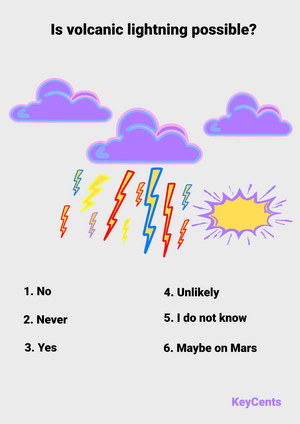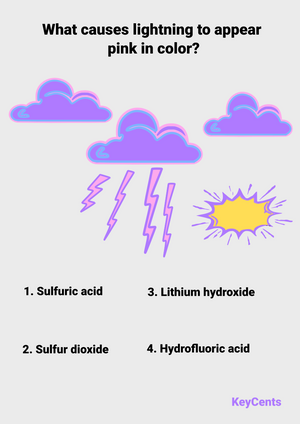
What gives lightning its different colors?
- Ionization
- Nitrogen molecules
- Particles in the air
- Sulfur dioxide
- Charge
- Ask the cat
The correct answer is: 4. Sulfur dioxide & 3. Particles in the air.
Explanation:
Lightning can display different colors due to a combination of factors related to the specific conditions in which it occurs. The colors of lightning are a result of the light emitted during the electrical discharge and how that light interacts with various elements and particles in the atmosphere. Here are the primary factors that give lightning its different colors:
- Volcanic Activity: During volcanic eruptions, ash particles and gases interact in the volcanic plume, causing electrical charges to separate and leading to the formation of volcanic lightning. The presence of volcanic gases, such as sulfur dioxide, and heated particles in the ash cloud can produce red, orange, and yellow hues in the lightning flashes.
- Snowstorms: Lightning that occurs during snowstorms can take on a greenish hue. This is because the lightning interacts with snow particles, which can bend the light and produce a greenish tint.
- Moisture Content: The color of lightning can be influenced by the amount of moisture in the air. Lightning can appear blue when there is less moisture in the air. On the other hand, when the light from lightning travels through more air, it can take on a purple or bluish hue, which occurs when the light gets filtered, leaving behind the purple appearance.
- Distance: The perception of lightning color can also be affected by the distance from the observer to the lightning. When observed from a very close distance, lightning may appear white because the light does not have to travel through much air before reaching the viewer's eyes, preserving its full spectrum.
- Atmospheric Scattering: Atmospheric particles, such as dust, water droplets, and other pollutants, can scatter light and influence the colors of lightning. This scattering effect can give lightning a range of colors depending on the atmospheric conditions.
It's essential to note that the colors of lightning can be challenging to observe accurately, especially during a thunderstorm when the flashes can be intense and brief. Additionally, the perception of color can be subjective and dependent on individual factors, such as vision and lighting conditions. Overall, the diverse palette of lightning colors showcases the complex and fascinating interactions between electricity and the Earth's atmosphere.












